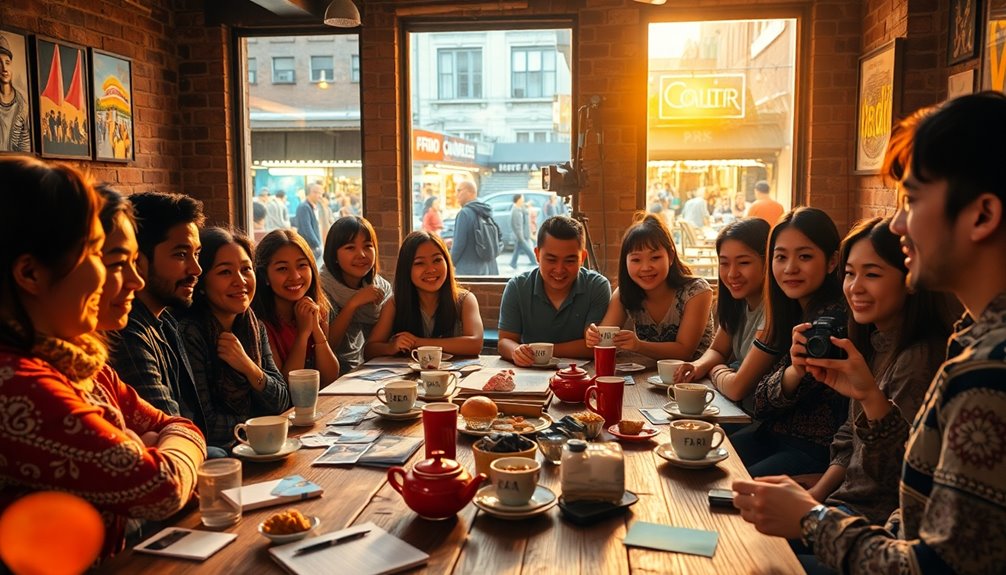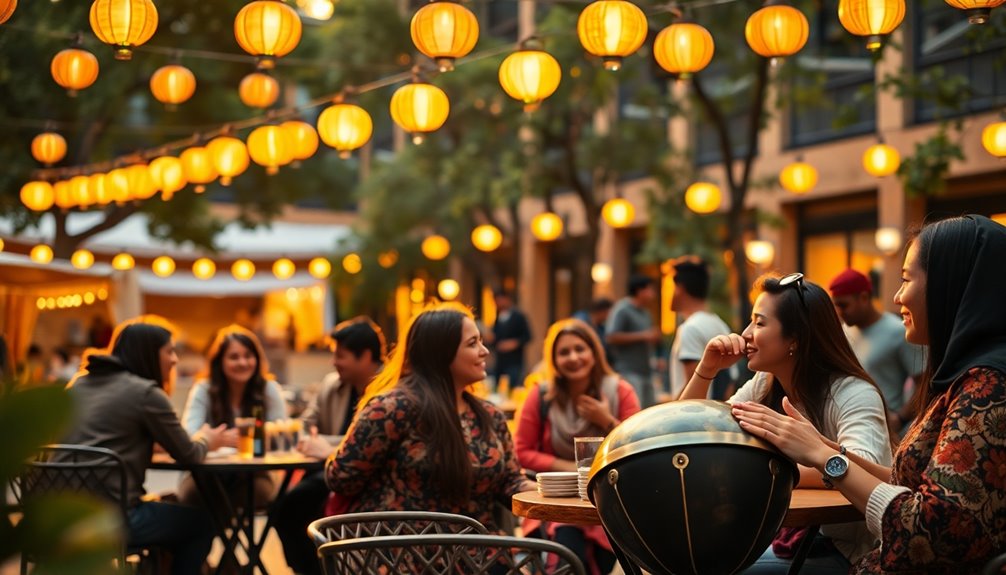
You’ll gain faster, more natural English by mixing classroom study with immersive homestays, community volunteering, and regional dialect workshops that teach local accents and storytelling. Try music nights, pub conversations, literary trails, and food-based role rotations to build informal fluency and cultural insight. Outdoor adventure programs add action-based vocabulary and teamwork skills, while digital tours and virtual guides broaden access to artifacts and context. Keep going and you’ll uncover practical ways to apply these trends.
Immersive Homestays With Local Families
Living with a local family gives you more than daily language practice — it plunges you into routines, values, and subtle cultural cues that textbooks miss. When you choose an immersive homestay, you get structured opportunities for cultural immersion while staying in a predictable, supportive environment. You’ll observe family traditions at meals, holidays, and quiet evenings, learning pragmatic language, gestures, and social rhythms. That lived exposure complements classroom learning by connecting vocabulary to real tasks—shopping, cooking, or asking for help—so you build confidence without undue risk. Hosts who prioritize safety and clear expectations help you navigate boundaries and emergency procedures, so you can focus on learning. Consider matching with families vetted by programs that check references, living conditions, and communication styles. By approaching homestays as collaborative exchanges, you honor household norms while gaining nuanced linguistic skills, emotional intelligence, and a grounded sense of belonging that enriches both study and personal growth.
Community Volunteering and Language Exchange Projects
Homestays give you a close-up view of daily life, and volunteering or joining language exchanges lets you take that view into the neighborhood level—working alongside locals on shared projects or practicing language in real-world contexts. You’ll find community engagement opportunities that match your interests, from environmental clean-ups to tutoring, and they’re designed to be safe, supervised, and meaningful. By contributing, you’re not just observing culture; you’re participating in it, which deepens language immersion and builds trust with residents. Practical collaboration teaches idiomatic speech, cultural norms, and nonverbal cues in ways classroom hours can’t. You’ll want clear guidelines, background checks, and organized coordinators, and reputable programs will provide them. Reflective debriefs and pairing with local mentors help you process experiences ethically and avoid unintended harm. Whether you prefer structured projects or casual language exchanges, combining service with study gives you a responsible, enriching path to improve English while supporting the host community.
Regional Dialect Workshops and Storytelling Nights
When you join a regional dialect workshop or a storytelling night, you’ll get direct access to the accents, rhythms, and local vocabulary that textbooks can’t capture; these events pair linguistic insight with cultural context so you learn how people actually speak and why they say things the way they do. You’ll practice dialect immersion in a supportive setting, guided by facilitators who break down phonetics, idioms, and social cues. Storytelling techniques are modeled and rehearsed, so you can experiment with narrative voice, pacing, and audience awareness without pressure. Activities mix linguistics, theatre, and local history, giving you a rounded sense of meaning and usage. You’ll leave with practical listening and speaking strategies, a small toolkit of regional expressions, and increased confidence to interact respectfully. Organizers usually emphasize consent and comfort—feedback is constructive and paced—so you can engage at your own level while gaining authentic, usable language skills rooted in community practice.
Music, Pub Culture, and Conversational Fluency
After exploring regional accents and storytelling, you’ll find music and pub culture give you a different, social route to fluent conversation — they show how language moves in real time, between songs, jokes, and rounds of banter. You’ll learn rhythm, timing, and register by listening to local songs and practicing call-and-response; music appreciation becomes a tool for decoding slang, emotion, and cultural references. In pubs you’ll observe informal speech, turn-taking, and nonverbal cues in a relaxed setting, so being mindful of pub etiquette helps you join conversations respectfully and safely. Combine attentive listening with low-pressure participation: sing softly, ask open questions, mirror polite behaviors, and note how humor and storytelling shift by context. This interdisciplinary approach ties linguistics, sociology, and arts education into practical exercises that build conversational confidence. You’ll leave sessions with clearer pronunciation, better pragmatic judgment, and reassurance that social risk can be managed thoughtfully.
Literary Trails and Book Club Immersions
Because walking the streets that inspired a novel or discussing its themes with a small group lets you connect text to place, literary trails and book clubs give you a concrete way to practice English that’s both analytical and social. You’ll follow mapped routes that highlight settings, motifs, and historical context, turning reading into embodied learning. Guided talks tie literature to architecture, local history, and social studies, so you develop vocabulary and cultural literacy together. In club settings, you’ll exchange interpretations in a moderated, respectful space that values clarity and listening, which keeps interaction safe and productive. Activities like literary scavenger hunts make close reading playful and scaffolded, helping you notice details and practice descriptive language. Occasional author meetups—live or virtual—offer insight into craft and intention, and you can prepare questions that deepen comprehension. Whether you prefer quiet reflection on a bench or lively small-group debate, these experiences help you build confident, contextualized English skills.
Multicultural Festivals and Cross-Cultural Conversation Labs

If you want lively, real-world practice that blends language with sensory culture, multicultural festivals and cross-cultural conversation labs give you complementary ways to learn: festivals immerse you in food, music, dress, and ritual that expand vocabulary and pragmatic understanding at a glance, while conversation labs focus on nuance, listening strategies, and repair techniques in a low-stakes setting. You’ll use cultural performance showcases to observe gesture, register, and storytelling rhythms, which helps you map language onto social practice. In parallel, conversation labs let you rehearse turn-taking, confirmation checks, and polite disagreement, guided by facilitators who prioritize emotional safety and clear feedback. Together, language immersion events and structured dialogue build transferable skills: interpreting context, managing breakdowns, and adjusting formality. You’ll leave festivals with embodied vocabulary and sensory anchors, and leave labs with pragmatic tools and confidence to engage across differences. Both contexts respect consent and boundaries, so you can explore identity and expression without pressure while developing practical communicative competence.
Culinary Experiences and Food-Based Language Practice
When you learn language through food, vocabulary and culture come together in tangible, memorable ways: recipes teach sequencing and imperatives, tasting sessions sharpen sensory adjectives, and shared meals surface politeness strategies and conversational rhythms you won’t pick up in a textbook. You’ll practice culinary vocabulary while following a recipe, asking about ingredients, and describing textures and aromas. Small-group recipe exchanges create low-pressure opportunities to rehearse questions, give step-by-step directions, and correct misunderstandings with supportive peers. Interdisciplinary ties to nutrition, history, and social etiquette deepen comprehension and make terms stick because they’re meaningful, not abstract. Instructors and hosts can prioritize accessibility and food safety, so you’ll feel secure trying unfamiliar dishes and phrases. By rotating roles—chef, taster, note-taker—you’ll build fluency in practical contexts and learn how food frames identity and hospitality. These food-based practices balance skill-building with cultural insight, helping you communicate confidently around meals in diverse English-speaking settings.
Outdoor Adventure Programs With Language Coaching
Although the trail’s rhythm might seem all about physical challenge, outdoor adventure programs with language coaching pair movement and meaning so you learn English through action: steering a map teaches directional vocabulary, campfire debriefs sharpen storytelling and past-tense usage, and gear briefings require precise, technical terms. You’ll move between task-based drills and reflective moments, so learning’s integrated with safety protocols and situational awareness. Instructors model clear commands and confirm comprehension before you try ropes, ensuring risk is minimized while communication skills grow. Outdoor team building exercises teach collaborative language—negotiating roles, giving concise instructions, and practicing conditional phrases under mild stress. Language immersion activities are structured: vocabulary lists tied to equipment, controlled role-plays for emergency responses, and guided observations that prompt descriptive language. You’ll leave with practical fluency: confident directional phrases, emergency vocabulary, and narrative competence from shared experiences, plus a respect for safety procedures that keeps both language and bodies secure.
Digital Cultural Tools and Virtual Guided Tours
You’ll find that digital cultural tools and virtual guided tours open access to places and practices you might never visit in person, blending multimedia storytelling, interactive maps, and language prompts to teach both vocabulary and cultural context. You’ll engage with digital storytelling that frames historical moments, oral histories, and everyday routines, so you learn idioms and registers in context. Virtual museums let you explore artifacts at your own pace, zooming into labels while audio guides model pronunciation and explain cultural significance. Because these tools are designed for accessibility and safety, you can control exposure, revisit challenging content, and use built-in glossaries or subtitles when you need clarity. Interdisciplinary features—linking linguistics, history, and media studies—help you reflect critically on representation and bias. Use guided tasks and reflection prompts to practice speaking and writing about what you’ve seen, and choose reliable platforms with clear privacy policies to keep your learning secure and focused.
Some Questions Answered
How Do Cultural Experiences Affect Language Exam Scores?
You’ll often see improved scores — but wait, there’s more: cultural experiences quietly reshape your test performance. By boosting language acquisition through authentic interactions and cultural immersion, you’ll gain pragmatic knowledge, richer vocabulary, and pragmatic confidence that exam tasks demand. Interdisciplinary exposure—history, media, social norms—gives safer, more intuitive comprehension strategies, so you’ll predict meaning and respond more accurately. Overall, measured gains follow from sustained, supported immersion that feels secure and guided.
Can Cultural Programs Be Customized for Advanced Learners?
Yes — you can get tailored experiences for advanced learners that match learner preferences and push proficiency. You’ll benefit from interdisciplinary content combining literature, media, and sociolinguistics, with tasks scaffolding challenge and safety. Programs can adapt pacing, feedback, and cultural depth while offering risk-aware immersion, virtual options, and reflective practice. You’ll feel supported as activities target pragmatic nuance, academic discourse, and authentic interaction, keeping your goals and comfort central.
Are There Safety Concerns With Immersive Homestays?
Like a lighthouse in fog, yes — there are safety concerns with immersive homestays, but they’re manageable. You’ll want clear homestay regulations and vetted safety protocols: host background checks, emergency contacts, health coverage, and orientation on local laws. Interdisciplinary checks — cultural norms, legal requirements, and psychological fit — protect you. Ask programs about incident response, supervision levels, and reporting processes so you can feel secure while engaging deeply.
Do Cultural Activities Offer Official Language Course Credits?
Sometimes they do: many programs let cultural activities count toward language credits when tied to assessed learning outcomes. You’ll want to confirm accreditation and assessment methods—reflective journals, presentations, or supervised fieldwork often qualify. Cultural integration is evaluated for language use, intercultural competence, and safety protocols. Ask your provider for syllabi, credit equivalencies, and risk-management plans so you’re assured credits are legitimate and your well-being’s protected.
How Do Online Cultural Tools Protect User Privacy?
Like a secure vault, online cultural tools protect your privacy by using data encryption to scramble information in transit and at rest, and by requiring clear user consent before collecting or sharing data. They combine legal, technical, and design approaches—minimal data collection, anonymization, access controls, and transparent policies—so you can explore safely. You’ll also find user-centered settings and audit logs that let you control who sees your cultural interactions.
Summing Everything Up
You might worry these cultural routes sound time-consuming or intimidating, but you’ll find they actually speed your progress and make English feel alive. By mixing homestays, music nights, food labs and digital tours, you’ll practice real conversation, pick up regional colors, and build confidence through meaningful connections. This interdisciplinary approach—social, cognitive, and experiential—puts you at the center, so learning becomes less about drills and more about richly felt discovery. Embrace it.
